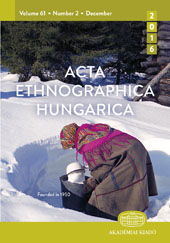Siedlungen an beiden Ufern der Donau in Ungarn vor 1920
Settlements divided by the River Danube in Hungary before 1920
Author(s): László LukácsSubject(s): Cultural history, Regional Geography, Historical Geography, Ethnohistory, Middle Ages, Modern Age
Published by: Akadémiai Kiadó
Keywords: integrating paired settlements; river crossing-places; ferries; bridge construction; flotage; boat-towing; transportation; corn trade; timber trade; railway construction; demographical development;
Summary/Abstract: In the territory of historical Hungary, there were several settlements, counties, towns, and villages divided by the river Danube. Counties situated on two sides of the river are typical of the territory lying to the west and south of the Danube-strait between Esztergom and Vác. At the time of the Hungarian Settlement (9th–10th century), the river never meant a dividing line for the Hungarian tribes settling down, and this fact influenced the formation of the counties situated on both sides of the Danube. The Counties Gyôr, Komárom, and Esztergom were areas divided by the Danube until 1920, and Fejér County was also until the end of the sixteenth century. In the Hungarian Calvinist church administration, there still exists the Calvinist Church District of the Danube-Side, which contains districts situated on both sides of the river Danube. The town of Buda and Pest united to form one settlement after the construction of the Chain Bridge (1848). A similar development seemed to be possible in the case of Esztergom and Párkány, Komárom and Újszôny, Pozsony and Pozsonyligetfalu joined by bridges and also in the case of Visegrád and Nagymaros having a ferry connection. Komárom united with Újszôny in 1896, and the two settlements were separated by the Trianon Peace Treaty in 1920. At the same time, we cannot find any united settlement-pairs divided by the Danube from the south of Budapest to as far as Újvidék-Pétervárad and Zimony-Belgrade. There are several villages known from the age of Árpáds in Csallóköz, Komárom County which had fields on both sides of the Danube. Such villages can also be found by the reach of the Danube between Budapest and Mohács, and in the later historical ages as well.
Journal: Acta Ethnographica Hungarica
- Issue Year: 50/2005
- Issue No: 1-3
- Page Range: 39-66
- Page Count: 28
- Language: German
- Content File-PDF

